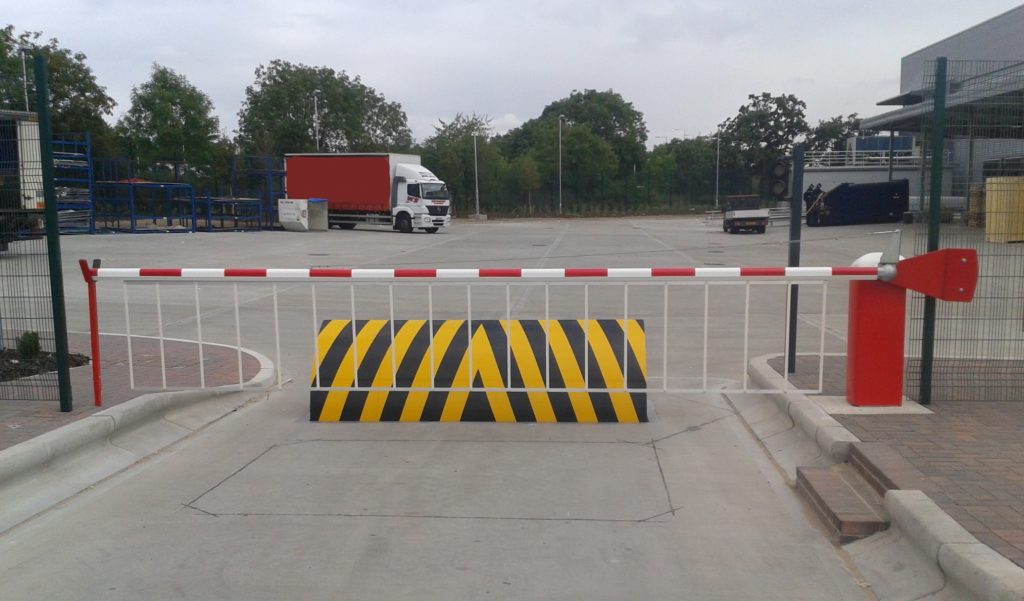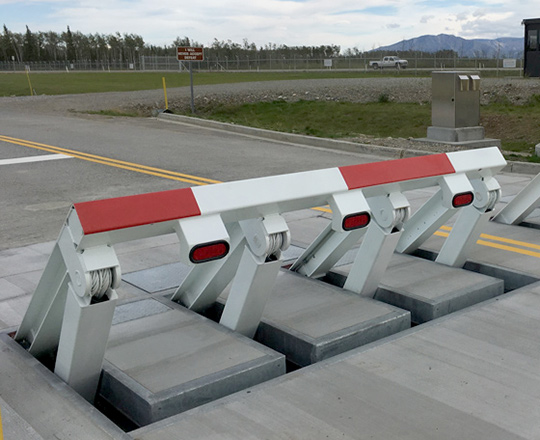Not known Facts About Wedge Barriers
Table of ContentsWedge Barriers for Beginners3 Simple Techniques For Wedge Barriers

14 and the surface area 12 to which the obstacle 10 is secured might be made from concrete - Wedge Barriers. 2, the obstacle 10 is placed to or includes a support or subframe (e. g., support 30 displayed in FIG. 2 )safeguarded beneath the surface area 12. The bather 10 might be bolted to the support or protected to the support by various other mechanical fasteners. In the illustrated embodiment, the barrier 10 includes a wedge plate 16, that includes a part that is considerably identical with the surface area 12 when the barrier 10 remains in the pulled back position. To put it simply, automobiles or individuals may pass over the obstacle 10 when the barrier 10 remains in the withdrawed setting and experience small altitude about the surface 12 while on the obstacle 10. As talked about carefully listed below, when the obstacle 10 is in the released position, the wedge plate 16 is held and supported in an elevated setting by a lifting device of the obstacle 10. Furthermore, the parts 18 may be bolted or otherwise mechanically coupled to each other. In this way, repair or substitute of one or more components 18 might be simplified and structured. That is, repair service or replacement of single parts
18 may be done faster, quickly, and price properly. FIG. In specific personifications, the anchor 30 might be a steel structure including plates, beam of lights(e. g., I-beams ), and/or various other frameworks that are safeguarded within the foundation 14, which may be concrete. At the surface area 12, an upper side 28 of the support 30 may be at least partly revealed
, consequently enabling the attachment of the barrier 10 to the anchor 30. g., threaded openings)in several beam of lights or plates of the support 30 may be subjected to the surface 12. In this way, screws 32 or various other mechanical bolts may be utilized to safeguard the barrier 10 to the anchor 30. As the obstacle 10 is placed to the surface area 12 of the structure 14, collection of debris and other material under the barrier might be minimized, and elements of the bather 10 may not be exposed to below grade atmospheres. As shown by recommendation character 52, the training device 50 includes elements disposed underneath the wedge plate 16. The elements 52 under the wedge plate 16 might consist of an electromechanical actuator, a cam, one or even more web cam surface areas, and so forth. In addition, the training device 50 includes a springtime setting up 54
The springtime rod 58 is coupled to a cam(e. g., cam 80 received FIG. 4) of the training mechanism 50. The springs 60 disposed about the spring rod 58 are held in compression by spring sustains 62, including a dealt with springtime assistance 64. That is, the set springtime assistance 64 is fixed about the structure 14 and the rest of the bather 10.
Our Wedge Barriers Ideas
g., spring support 65 )might be repaired to completion of the spring rod 58 to allow compression of the springs 60. As the springs 60 are compressed between the springtime sustains 62, the spring setting up 54 produces a pressure acting on the camera coupled to the spring pole 58 in a direction 66. For instance, the continuing to be force put on
the cam to release the wedge plate 16 might be given by an electromechanical actuator 84 or other actuator. The springtime setting up 54 and the actuator 84(e. g., electromechanical actuator)might run together to convert the webcam and raise the wedge plate 16.
As pointed out above, the spring assembly 54 exerts a constant force on the webcam, while the electromechanical actuator might be regulated to apply a variable pressure on the cam, thus allowing the training and decreasing( i. e., releasing and pulling back )of the wedge plate 16. In certain personifications, the consistent pressure used by the spring assembly 54 may be adjustable. g., electromechanical actuator) is disabled. As will be valued, the spring assembly 54 might be covered and shielded from debris or various other components by a cover plate(e. g., cover plate 68 received FIG. 4) that may be significantly flush with the raised surface area 38 of the structure 14. As stated over, in the released position, the wedge plate 16 serves to block accessibility or traveling past the obstacle 10. The barrier 10(e. g., the wedge plate 16 )might block pedestrians or cars from accessing a building or pathway. As reviewed over, the barrier 10 is connected to the support 30 protected within the foundation 14,

front braces 71. Consequently, the affiliation visit assemblies 72 might pivot and revolve to enable the collapse and expansion of the link settings up 72 during retraction and implementation of the bather 10. The affiliation assemblies 72 cause movement of the wedge plate 16 to be limited. If a vehicle is taking a trip towards the released wedge plate 16(e. For instance, in one circumstance, the safety and security legs 86 might be prolonged duringmaintenance of the barrier 10. When the security legs 86 are deployed, the security legs 86 support the weight of the wedge plate 16 against the surface area 12. Therefore, the lifting mechanism 50 may be shut down, serviced, removed, replaced, etc. FIG. 5 is partial viewpoint view of an embodiment of the surface-mounted wedge-style barrier 10, illustrating the cam 80 and the web cam surfaces 82 of the training device 50. Particularly, two webcam surfaces 82, which are described as lower webcam surfaces 83, are placed listed below the web cam 80. The lower web cam surfaces 83 might be dealt with to the surface area 12 (e. For instance, the lower web cam surface areas 83 and the installing plate 85 may create a solitary item that is safeguarded to the anchor 30 by bolts address or other mechanical bolts. In addition, 2 cam surface areas 82, which are referred to as top camera surfaces 87, are placed Wedge Barriers over the webcam 80 and coupled to (e. In various other embodiments, interfering layers or plates might be placed in between the surface 12 and the reduced cam surfaces 83 and/or the wedge plate 16 and the upper web cam surfaces 87 As discussed above, the camera
80 translates along the webcam surfaces 82 when the wedge plate 16 is raised from the pulled back placement to the deployed placement. Additionally, as mentioned above, the springtime setting up 54 (see FIG. 3 )may supply a pressure acting on the webcam 80 in the instructions 102 via spring pole 58, which may reduce the force the electromechanical actuator 84 is needed to use to the webcam 80 in order to actuate and lift the wedge plate 16. 1 )to the released placement(see FIG. 4). As revealed, the webcam 80 includes track wheels 104(e. g., rollers), which call and translate along the cam surface areas 82 throughout procedure.